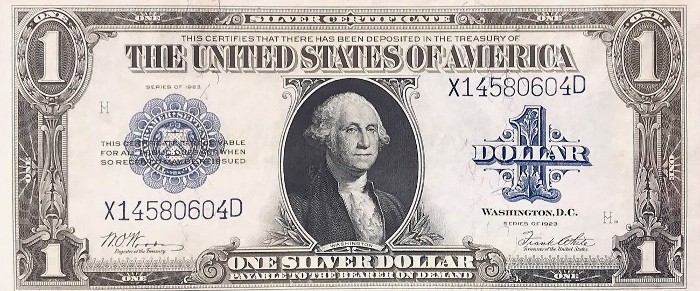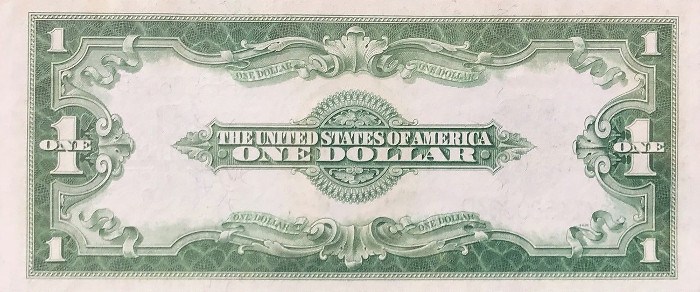The 1923 one dollar silver certificates are the most common of the large silver certificates. They are old, but they aren't that valuable because millions were printed and many people saved them. Tens of thousands of them are still in existence.
These silver certificates have a blue seal. If your note has a red seal then it's not a silver certificate, it would actually be a 1923 one dollar legal tender note.
There are three different signature combinations for this series. The common ones are Speelman and White, followed by Woods and White. The signature combination of Woods and Tate is the rarest, although it's still fairly common.
This bill is sometimes called "horse blanket" due to its size. But the 1923 note is not the only bill to be called horse blanket, as it's a term used to describe any large bill. The term horse blanket refers to the bill being large enough to cover the back of a horse. The 1923 notes and other large currency notes are about 25% larger than the current US bills in circulation.


Specifications
| Denomination: | $1.00 U.S. Dollar |
| Series: | 1923 |
| Type: | Silver Certificate |
| Note Size: | Large |
| Portrait: | George Washington |
| Signature Varieties: | 3 |
How Much Is Your Bill Worth?
The value of these silver certificates will depend on the signature variety and the condition.
Bills signed by either Speelman and White or Woods and White are less valuable. Bills with either of these signature combinations are worth around $37.50 in very good condition. In very fine condition the value is around $62.50. In extremely fine condition the value is around $75. Uncirculated bills with a grade of MS 63 can sell for around $195.
Bills signed by Woods and Tate are more valuable. These bills are each worth around $90 in very good condition. In very fine condition the value is around $250. In extremely fine condition the value is around $425. Uncirculated bills with a grade of MS 63 can sell for around $725.
There are other factors that could make your note more valuable. For example, your note will be more valuable if it has either a low serial number or a block serial number.
There are also star notes, which are slightly more rare. Star notes are replacement notes that have a star symbol either before or after the serial number. These notes are more valuable but there are still many 1923 one dollar silver certificate star notes.
Note: Valuable bills should be placed inside large-size currency holders.
Grading System
Very good- A circulated note that has considerable wear to it. There might be one or two tears on the edge of the note. The note may be discolored, dark in appearance, or limp.
Very fine- A note that has been in circulation but not for a long time. The note is still relatively crisp. There may be some creases, folds, or light smudges.
Extremely fine- A note that shows small signs of having been in circulation. The note will be bright and it will have almost all of its original crispness. There might be one or two minor creases or folds but there are no stains, discolorations, or tears.
MS 63 choice uncirculated- A note that shows no signs of ever having been in circulation. The note still has its original crispness. The note is also well-centered.
Sources:
A Guide Book of United States Paper Money
See also:
1928 One Dollar Silver Certificate 1934 One Dollar Silver Certificate
